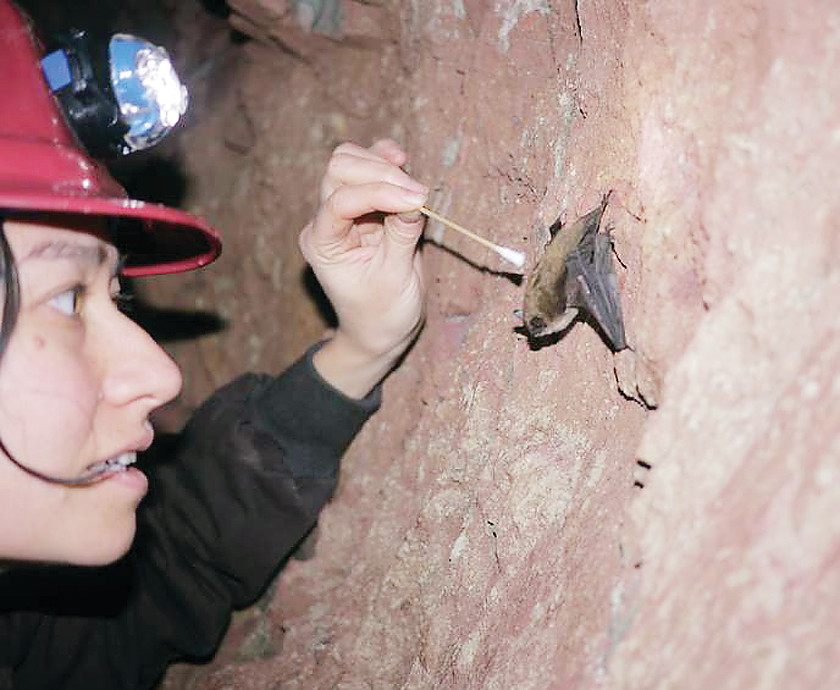Support the Timberjay by making a donation.
Will Soudan Mine research save our bats?
Research team studies mine’s unusual bacteria in hopes of finding a cure for whitenose syndrome
SOUDAN— Could bacteria in ancient water found deep in the Soudan Mine yield a cure for a disease that threatens to wipe out entire bat populations in North America?
That’s the question …
This item is available in full to subscribers.
Attention subscribers
To continue reading, you will need to either log in to your subscriber account, or purchase a new subscription.
If you are a current print subscriber, you can set up a free website account and connect your subscription to it by clicking here.
If you are a digital subscriber with an active, online-only subscription then you already have an account here. Just reset your password if you've not yet logged in to your account on this new site.
Otherwise, click here to view your options for subscribing.
Please log in to continue |
Will Soudan Mine research save our bats?
Research team studies mine’s unusual bacteria in hopes of finding a cure for whitenose syndrome
SOUDAN— Could bacteria in ancient water found deep in the Soudan Mine yield a cure for a disease that threatens to wipe out entire bat populations in North America?
That’s the question currently being explored by Christine Salomon, a University of Minnesota researcher who is working to isolate and grow unusual bacteria that have been found growing in salty brines deep in the mine. Salomon is hoping that anti-fungal properties she’s already detected in some of the bacteria, could provide a cure for whitenose syndrome, a deadly bat disease that has already killed millions of overwintering bats in the eastern U.S. and threatens to cause similar damage to the thousands of bats that hibernate each winter in the Soudan Mine.
Salomon outlined her work during a recent presentation sponsored by the Ely Field Naturalists, held at Vermilion Community College.
The existence of the brines, which could date back as much as two billion years ago, or more, was first discovered about five years ago by another U of M researcher. The calcium chloride brines are extremely salty, two to three times saltier than seawater, and may have been trapped when the surrounding rock was created between 2.4 and 2.8 billion years ago. The water is devoid of oxygen and organic material, but is extremely high in iron, and several other metals, including mercury, copper, and cobalt. Despite such conditions, researchers found that these brines actually contain living bacteria that appear to derive sustenance from the iron and other chemicals in the water. “We’re pretty sure many of these are new species that have never been described,” she said.
Salomon has also found unusual bacteria on the mine’s tenth level, living in conditions that would kill almost any other living thing known to science. In that case, water percolating from the rocks has extremely high levels of copper, which makes it toxic to most life. “This is a very hostile place,” said Salomon, “but when we sample these rocks, they’re full of bacteria that are resistant to these high metal levels.”
In addition, Salomon has isolated still more bacteria by taking swabs from bats in the mine, and she’s been culturing those, along with the bacteria from the brine and elsewhere, in hopes of learning more about their properties.
It’s basic science in a nutshell— gathering unknown bacteria, culturing them in a lab, and testing their properties. Salomon has already noted that a few of the new bacteria have proven to kill off fungi, and she’s since drafted a proposal to extend her research to test these anti-fungal bacteria on Pseudogymnoascus destructans, the fungus that scientists believe is the cause of whitenose syndrome.
According to Salomon, her lab only recently obtained clearance and approval to acquire the deadly, but slow-growing, bat fungus. She and her team are currently in the process of fine-tuning their methods and have yet to actually test any of her potential bacteria on the fungus. She said she is currently working with two other closely-related, and faster grower, fungal strains, obtained from the Soudan mine, to see if they are similar enough to the deadly variety to use for testing.
“Ultimately, we will test all of our top hits against the pathogen,” she said.
And even if her research finds a compound that proves effective against the deadly fungus, Salomon said it would likely take a year or more to develop an actual treatment. After completing lab testing, she said her team would still have to test whether it’s safe for hibernating bats. “Since this has never been done before we would also have to develop and optimize the delivery method as well. But I plan to bring in experts in each of these areas to help once we do the initial screening and identification of the biocontrol agent(s),” stated Salomon in an email.
Salomon and others are holding out hope that they might find a treatment for the deadly fungus before it has a chance to wipe out bat populations across the U.S., including here in Minnesota. In 2012, researchers found two bats at Soudan, out of one hundred sampled, that tested positive for the presence of the fungus. Neither bat showed symptoms of the disease and subsequent testing has not found any additional bats that appear to have been exposed. “We just did our latest bat count in March, and saw no sign of infection,” said Salomon. But scientists say it’s just a matter of time before more exposed bats arrive at the mine, and the disease takes hold. Humans can also carry the fungus on their shoes or clothing, so Soudan Mine park managers have already instituted steps to try to prevent that from happening.
Meanwhile, Salomon and her team, are in a race against time, believing that the Soudan Mine, and its unusual bacteria, may hold the key to controlling this catastrophic bat epidemic.






